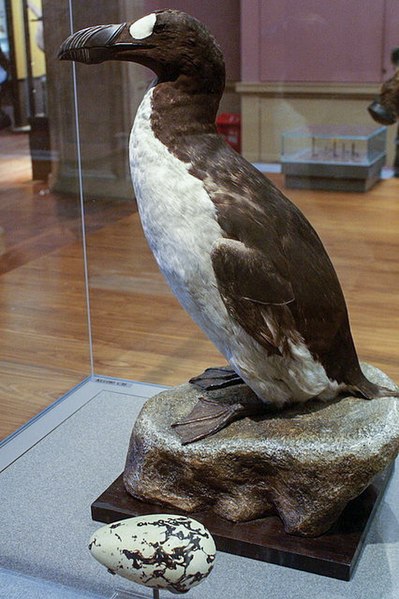پرونده:Great Auk (Pinguinis impennis) specimen, Kelvingrove, Glasgow - geograph.org.uk - 1108249.jpg

اندازهٔ این پیشنمایش: ۳۹۹ × ۵۹۹ پیکسل. کیفیتهای دیگر: ۱۶۰ × ۲۴۰ پیکسل | ۴۲۶ × ۶۴۰ پیکسل.
پروندهٔ اصلی (۴۲۶ × ۶۴۰ پیکسل، اندازهٔ پرونده: ۲۷۱ کیلوبایت، نوع MIME پرونده: image/jpeg)
تاریخچهٔ پرونده
روی تاریخ/زمانها کلیک کنید تا نسخهٔ مربوط به آن هنگام را ببینید.
| تاریخ/زمان | بندانگشتی | ابعاد | کاربر | توضیح | |
|---|---|---|---|---|---|
| کنونی | ۱۱ اوت ۲۰۱۷، ساعت ۰۹:۲۶ |  | ۴۲۶ در ۶۴۰ (۲۷۱ کیلوبایت) | Archaeodontosaurus | Corrections |
| ۲۴ فوریهٔ ۲۰۱۱، ساعت ۱۷:۴۶ |  | ۴۲۶ در ۶۴۰ (۷۸ کیلوبایت) | GeographBot | == {{int:filedesc}} == {{Information |description={{en|1=Great Auk (Pinguinis impennis) specimen, Kelvingrove, Glasgow A lost part of the biogeography of Britain, and the only flightless bird that has bred in Europe in historical times. The last Great Auk |
کاربرد پرونده
صفحهٔ زیر از این تصویر استفاده میکند:
کاربرد سراسری پرونده
ویکیهای دیگر زیر از این پرونده استفاده میکنند:
- کاربرد در ar.wikipedia.org
- کاربرد در arz.wikipedia.org
- کاربرد در ast.wikipedia.org
- کاربرد در as.wikipedia.org
- کاربرد در az.wikipedia.org
- کاربرد در bg.wikipedia.org
- کاربرد در bn.wikibooks.org
- کاربرد در ca.wikipedia.org
- کاربرد در da.wikipedia.org
- کاربرد در de.wikipedia.org
- کاربرد در en.wikipedia.org
- کاربرد در en.wikibooks.org
- کاربرد در en.wiktionary.org
- کاربرد در es.wikipedia.org
- کاربرد در et.wikipedia.org
- کاربرد در eu.wikipedia.org
- کاربرد در fi.wiktionary.org
- کاربرد در fo.wikipedia.org
- کاربرد در fr.wikipedia.org
- کاربرد در fy.wikipedia.org
- کاربرد در ga.wikipedia.org
- کاربرد در gd.wikipedia.org
- کاربرد در gl.wikipedia.org
- کاربرد در he.wikipedia.org
- کاربرد در ia.wikipedia.org
- کاربرد در it.wikipedia.org
- کاربرد در ja.wiktionary.org
- کاربرد در jv.wikipedia.org
- کاربرد در la.wikipedia.org
- کاربرد در lv.wikipedia.org
- کاربرد در ml.wikipedia.org
- کاربرد در mrj.wikipedia.org
- کاربرد در no.wikipedia.org
نمایش استفادههای سراسری از این پرونده.
